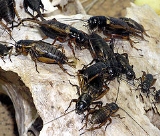
Gryllus bimaculatus
Encyclopedia
Gryllus bimaculatus is one of many cricket species known as the Field cricket
. Also known as the African or Mediterranean field cricket or as the two-spotted cricket, it can be discriminated from other Gryllus species by the two dot-like marks on the base of its wings.
This species of cricket is popular for use as a food source for insectivorous animals like spider
s and reptile
s. They are easy to raise and do not require prolonged exposure to cold temperatures in order to complete their life cycle.
has been implicated in the nocturnal rhythms of crickets.
, which is used to lay eggs into the ground. They lay their eggs into humid soil and the baby crickets hatch in about two weeks.
Field cricket
Field crickets are insects of order Orthoptera. These crickets are in subfamily Gryllinae of family Gryllidae.They hatch in spring, and the young crickets eat and grow rapidly. They shed their skin eight or more times before they become adults.Field crickets eat a broad range of feeds: seeds,...
. Also known as the African or Mediterranean field cricket or as the two-spotted cricket, it can be discriminated from other Gryllus species by the two dot-like marks on the base of its wings.
This species of cricket is popular for use as a food source for insectivorous animals like spider
Spider
Spiders are air-breathing arthropods that have eight legs, and chelicerae with fangs that inject venom. They are the largest order of arachnids and rank seventh in total species diversity among all other groups of organisms...
s and reptile
Reptile
Reptiles are members of a class of air-breathing, ectothermic vertebrates which are characterized by laying shelled eggs , and having skin covered in scales and/or scutes. They are tetrapods, either having four limbs or being descended from four-limbed ancestors...
s. They are easy to raise and do not require prolonged exposure to cold temperatures in order to complete their life cycle.
Fighting
In the wild, male crickets do not tolerate one another and will fight until there is a winner. The loser usually retreats without serious injury. The fighting method involve opening the mandibles as wide as possible, gripping onto the opponent's mandibles and pushing with the hind legs. There is a strange behavior involving flight - this activity seems trigger its fighting spirit.Chirping
Male crickets of this specie produces several distinctive chirping sounds. The sounds are made by rubbing its two outer wings together. Loud and steady chirps made during the night until dawn is to attract potential females and to warn off other males. Loud chirps with a fast frequency can be heard when a male encounters another male and is preparing to fight. It is made to scare off the other rival male. A soft clipping sound is made when there is a female nearby. It is made to encourage the female to mate.Shelter
These crickets can be found hiding under logs, grasses, and in crevices. They can also dig holes into the ground to create homes for themselves, or live in holes created by other animals. Males are territorial and will fight off other males, but allow any number of females to coexist in the same shelter.Cannibalism
This behavior is extremely rare, but females have been observed to cannibalize the male if there is not enough food to eat.Circadian Rhythm
In recent studies, Pigment Dispersing FactorPigment dispersing factor
Pigment dispersing factor is a gene that encodes for the protein PDF, which is part of a large family of neuropeptides. The analogous hormone, pigment dispersing hormone was named for the diurnal pigment movement effect it has in crustacean retinal cells, and was initially discovered in the...
has been implicated in the nocturnal rhythms of crickets.
Physiology
Females have a tubular organ at the rear, known as an ovipositorOvipositor
The ovipositor is an organ used by some animals for oviposition, i.e., the laying of eggs. It consists of a maximum of three pairs of appendages formed to transmit the egg, to prepare a place for it, and to place it properly...
, which is used to lay eggs into the ground. They lay their eggs into humid soil and the baby crickets hatch in about two weeks.

